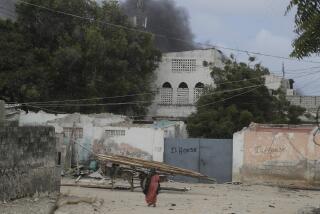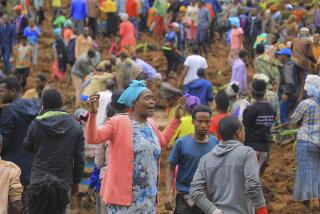Somalia famine spreads to 3 new regions, U.N. says
With hunger in the Horn of Africa dramatically worsening, the United Nations on Wednesday added three more regions of Somalia to the list of areas it says are stricken by famine.
More than 12 million people are facing starvation, with children particularly vulnerable. The U.N. last month declared that two regions of Somalia were suffering from famine, and it said Wednesday that the famine was likely to spread across most of Somalia in coming months, as well as parts of Kenya, Uganda and Ethiopia.
Somalia is struggling with its worst drought in 60 years, and 3.7 million Somalis are in crisis, mainly in the south — creating Africa’s most serious hunger crisis in two decades. Refugee camps in the capital, Mogadishu, are now affected as well, U.N. agencies said.
PHOTOS: Somalis flee war and drought
Shocking images of those suffering have resulted in an increase in aid in the last two weeks, after donors’ earlier sluggish response, but violence in the south of the country has limited humanitarian agencies’ access.
The U.N. is seeking to raise $1 billion to address the crisis.
“The current situation represents the most severe humanitarian crisis in the world today and Africa’s worst food security crisis since Somalia’s 1991-92 famine,” said a statement Wednesday by the U.S.-funded Famine Early Warning Systems Network, or FEWS NET. It called for a massive global response to prevent more deaths and social collapse.
Increases in food prices are expected to exacerbate the crisis, according to U.N. humanitarian agencies and FEWS NET.
About 860,000 people have trekked out of Somalia, often leaving dead children on the way, hoping to find food in neighboring countries. An additional 1.5 million people have fled drought-ridden areas of Somalia for other parts of the war-torn nation.
Somalia has endured two decades without a functional government, and entrenched clan warfare. Multiple peace deals and efforts to establish a government have failed.
The current crisis is exacerbated by fighting between Somalia’s weak transitional government, which controls a few areas of the capital, and the extreme Islamic militia Shabab, which is allied with Al Qaeda and controls much of the south.
The insecurity in the south and Shabab’s policies drove out Western aid agencies last year, making it difficult to increase operations quickly to feed the hungry. The group imposed taxes on aid groups and banned female staff.
The U.N. declared last month that the Bakool and Lower Shabelle regions of Somalia were suffering from famine. On Wednesday, Middle Shabelle and camps for displaced people in the Afgooye corridor and Mogadishu were added.
The crisis is expected to continue until at least the end of the year.
PHOTOS: Somalis flee war and drought
More to Read
Sign up for Essential California
The most important California stories and recommendations in your inbox every morning.
You may occasionally receive promotional content from the Los Angeles Times.










